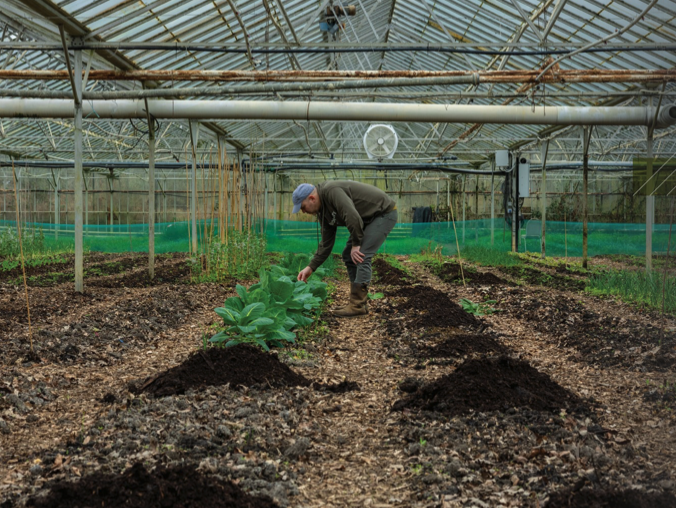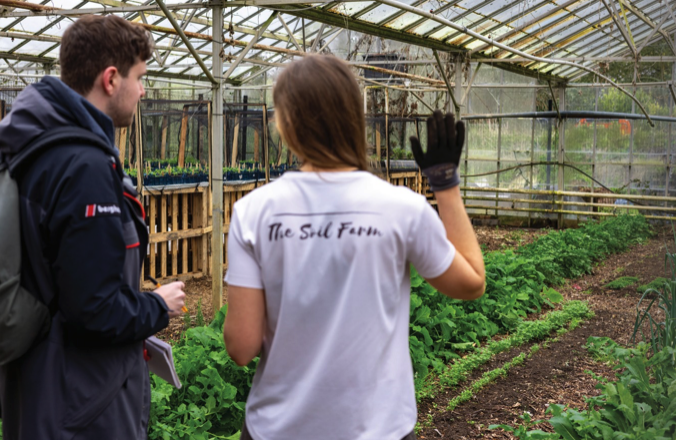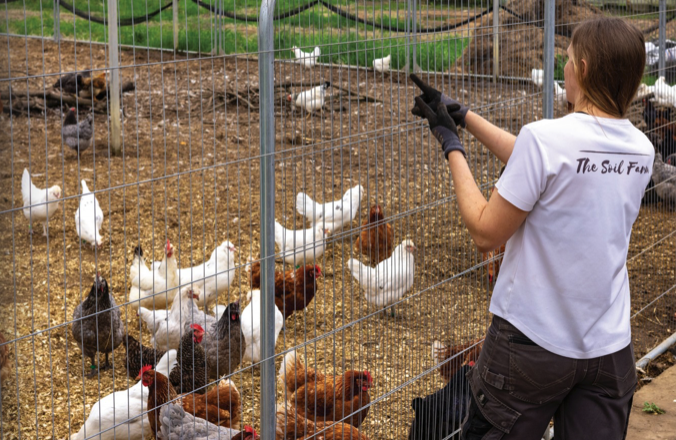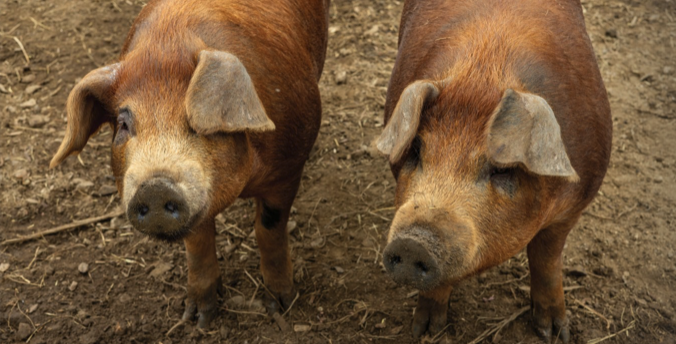


In today's world, there's nothing ordinary about the way Jock Pettitt and Sasha Marsh produce food on their farm. But in the years gone by it was exactly the way it was done. First by nature, then by us.
And in the world of tomorrow, it might be one of the ways to which we must return. Not out of convenience, but out of necessity. Small scale regenerative farming is the name of their game.
That means no artificial additives, no standalone fields filled only with one type of plant, and an overarching aim of improving the soil after taking out of it.
In around four years, The Soil Farm has managed to turn that ambition into the makings of one of most bountiful and environmentally restorative food production initiatives in Guernsey to date.
Not only have Jock and Sasha begun to commercially expand this type of system, but they have also amassed a deep knowledge of how we got here, and what can be done to remedy it.
And they see it as a project that’s much wider than just a day job - they see responsibility and the chance for an incremental reset in our relationship with sustenance and work.
If they’re successful then they hope there won’t just be visible changes to their balance sheet and the land they manage, but the island’s food system too.
The business currently operates out of a greenhouse. A pilot market garden of 100sqm initiated last year has produced 700kg of food so far, which gave them the confidence to massively ramp up production in the same style this year.
The pilot beds continue to provide seasonal produce including kale, chard, turnips, leeks, and beetroot as part of a full year cycle. Herbs will be grown in this area once the new market garden is fully operational.
You could call their approach ground-breaking. But something unique to The Soil Farm is that they operate a no-dig system of farming.
“The biggest difference here is that we're trying to build an ecosystem,” Jock said. “We're trying to invest in the substrate, the organic matter, the biology, and the inputs so that the system will start to create its own cycle and its own balance.
“We're trying to create a system that looks after itself to some extent and then we become the guardians to just help it along.”

Balance, harmony, and mimicry are words in their verbal toolbox that they often deploy.
“Obviously, if we're planning to take out of the system, we must put something back. We just work to make sure that we mimic nature wherever possible, we build a cyclic system and we invest in the biology in that system so that they can do most of the work.
“And the difference between that and a conventional system is that a conventional system is based on annual inputs of mostly, well, quite often synthetic inputs and turning the land to break it up and make it usable again.
The romanticised view of farming, pushed further into public consciousness by Amazon’s wildly successful Clarkson’s Farm, is of a countryside made productive through heavy machinery, specialised tools, and bag after bag of fertiliser, pesticide, herbicide, fungicide, and insecticide.
But in reality, these practices have been used for less than a century.
Central to The Soil Farm is that no spades, ploughs, or cultivators touch the ground, which is why “no diggity” features on some of their merchandise. They claim this is essential to respect the natural processes buried in the soil.
“Part of that for us is down to the oxygenation and fungi and the aeration in the system. The biology that's living in there creates the aeration, the fungi populate and provides the networks and the oxygen, and the oxygen is held in that space,” Jock said.
“The moment we turn all that over, we break all those three… there's only so many times you can keep taking it up and putting it back before it degenerates year on year."
They both agreed that more hands-on labour is necessary to make their system work, especially since the use of machinery is off-limits. But while more time may need to go into the farm, more comes out of it.
Sasha said that is always the tradeoff in creating a “biological system rather than a synthetic reliance system.
“It's very hands-on.The majority of our labour will be in preparing and picking. It will be concentrated around the food rather than around the soil preparation and soil management. It's a different focus”.
A different focus in their case does result in different outcomes, however. Jock explained: “The kilos per square metre - if we go for the metric output - will be much greater than a conventional farm output. And so, the time per square metre will also be greater.
He said more data needs to be gathered from the scaled-up production, but he expects to see an encouraging trend.
“Broadly, when you scale both of those two up, you'll find reasonable parity. I think we get more from the ground, but we put more into the ground as such.
“When you're working manually with the ground you can see it, you can feel it, you can use your senses. You get a much stronger and different relationship with what you're working with. And it's that instinctive decision making which informs the success of this type of system. You have to be close to it.

As well as believing their farm can produce an impressive quantity of products given the time inputs, they think the food is more nutritious and delicious because of their strict practices.
“We also believe that because it's a living system, providing the nutrient cycling, the plants that we are growing will have access to a lot more diversity of nutrients and minerals as well,” Sasha said.
Jock agreed: “The nutrient density in the plant is one of the core reasons why we're here. There's no point in just having food. We need minerals, we need nutrients, we need health from our food system rather than building a health system to supplement our food system.
A new scheme started earlier this year involves getting anyone interested to help. The idea is to turn-up for at least a few hours on a Saturday to work the land. More hours equal more perks, such as a branded t-shirt after three separate stints. 10-hours of commitment leads to a discount on their products, and each session provides a community workout to boot.
They said just two people can turn-up, sometimes 10, and sometimes none.
A cynic could call it free hard labour. They call it Farmer Gym.
Sasha said it was a natural response to people who were already offering their assistance.
“We were getting calls for people wanting to volunteer, and we wanted to embrace that, and we certainly could do with the extra help.But also we wanted to focus it into reconnecting these people. The people seem to want to volunteer because they wanted to get reconnected back to food, and understand what was happening.
Education has also been enabled: “The people that have come have really had their eyes opened as to what a natural system looks like, what they hadn't quite understood about where their food is coming from, and understanding if you're buying from supermarkets, does my food production look like this?
“We appreciate the extra help, but we're really hoping that people enjoy Farmer Gym. It's an honest workout, it's fresh air. We get a lot of people that come who work in an office and go to a standard gym and actually enjoy coming here because it's a different way of working. It's a whole-body workout with dialogue, that’s community-based and social."
After the interview I decided to see what it was like. The task of the day was to finish preparing several rows of their no-dig beds for their expanded market garden, ready for planting this spring.
It was repetitive and methodical but undeniably sociable – with each stage of progress tangible.
A wooden frame was used to mark out each row, meticulously measured and positioned on each row based on countless hours of spreadsheet planning to maximise efficiency.
On top of the existing ground were layers of cardboard. Top that with two bucket loads of leaves, a sprinkle of biochar and two barrows worth of their homemade compost and the job was done – for that row at least.
Every edge had to be treated to buckets worth of woodchips – the only material they need to buy in specially. They said this helps to stop any loose compost running off.
I quickly saw why time and hands are precious commodities at this farm. Dumping the materials in the frame was the easy bit. Constantly going back to the piles of ingredients, filling up and carting them back was heavy on the watch and the back.
It took four people several hours to finish just seven or so beds, and no seeds or saplings ever entered the ground on that occasion.
“What you can see here when you come and engage with it, spend an hour with us on the farm, you'll soon know what it takes to produce the carrot and then you value it completely differently, especially when you see the nutrients and the system's going into it,” Jock said.

Jock argued The Soil Farm and its methods are just a part of what could become a blueprint for the future of food production on a local scale.
“Ultimately, what we’re working towards is several farms with a blueprinted, copy and paste infrastructure to scale farming on the island. That's not necessarily every square inch, but really positive efficient farming systems where people would come to volunteer and trade there. That's a great goal I think.
“Part of that blueprint is trying to understand the labour and the cost point of food and work with that so we can make the best quality, nutrient dense food possible.
“We can put that on the shelf at an honest price so that the farmer isn't asked to bend over backwards for no money.
A recent trip to a UK farm shop growing and selling regenerative produce spurred not just an agreement for collaboration with them, but also a reality check into the true costs of well-produced food.
They saw 15 or so leaves of cavolo nero, much like what is currently growing in their greenhouse, selling for £6.50 a bunch.
“We're looking at that and thinking, crikey, we're not charging enough. But at this time of year, that's what they're charging for it. When you compare it nutrient to nutrient with what's on the shelf elsewhere, you'll probably find they stack up, but that's not the way we currently measure what we buy,” Jock said.
“When you look to produce food in an authentic and regenerative way, working with welfare at the top of your list, working with standards at the top of your list, working with biological systems, investing time in every other business that you look at, you add those things up and there's your price for your product.
The pair have gained confidence from already attacking the top and bottom ends of the market through those already able to pay a higher food bill, and from produce donations into the local welfare system from generous individuals.
“Now what we've got is that the top end of the system, who can afford it are able to eat the best food available, and the people who can't afford it are able to eat the best food available,” Jock said. “But the gap is in the middle and Farmer Gym in part is about trying to close that gap”.
Enter the concept of community farming and trading. During the interview I suggested the phrase ‘give me an hour and I’ll give you some food’, much to the delight of the pair.
“You can afford it if you choose to come and do a workout two hours a week. Value that time at £20 an hour and that's a £40 bag of food.
“The point is Farmer Gym can help reduce the cost point on the shelf for those who engage. What we can't do is give the food away because there are costs. But again, like everything here, it's not a one answer thing. It's a cyclic system, a multi-dimensional decision-making framework, and that part is just one detail within it.
Jock suspects that Channel Island food production is in the single digits in percentage terms. He thinks their model is one way of addressing the deficit between imports, which can fall victim to external influences, and seasonal production.
“This is our next step of changing those numbers, changing those percentages. And as we do so we've got to make sure we can manage our cash flow. Single digit numbers is what I suspect we're working with. If we take the question of food security and environment sustainability, we've got to address that differently.
“We can't be, I don't think, reliant on import, especially when you look at the geopolitical backdrop that we're currently walking into, which is probably going to be the next decade, if not longer.”

He asked if it would be possible to change local production from, for example, 3% to 30%.
“What we're working hard on here with the data and the numbers of this enterprise on this scale, noting that we're actively looking to scale up and realise a much larger farm on island.
“What percentage can we produce here? And because as you've seen, it's repeatable, it's measurable, it's scalable. We know how many kilos we pulled out of how many square metres last year and how many varieties that was, and therefore what diversity there was. If we can take those numbers and start to answer some of those questions, we know how many times to copy and paste that model before we can start to hit some of the numbers.
“And if we can get others to see that the value the, the income that they can make from this business is viable in a local context, then maybe other people will make the same decision.
“If we can blueprint that and get more and more people working in this space, then I don't think we'll be out of business because we'll continue - we're here because of passion. And I think that same thinking is if you can prove that this works, you de-risk it for a number of other people who would choose to do this work.
“It's certainly not a system where it's just us, it can't be just us. That's back into the conventional farming model.”
The best way to help their mission is to buy that type of produce, he added.
Looking to the future and possibilities to innovate, they have so far resisted suggestions of deploying vertical farming, artificial intelligence, and mechanised harvesting.
“There's time for that, as I'm sure somewhere these systems are efficient, but I think what you need to do is build the system and get it working and then look at how you optimise rather than rush to optimise,” Jock said.
“In 20-30 years time when we've maxed out the potential of this system, maybe there's room to innovate. But right now, we've got so much latency in land and system that we're not employing that. First we've got to get the soil right.
“What we know is that around the world the regenerative farming community is collaborative and working hard in sharing development and research on the ground in very open frame thinking.And we're tapped into that.
“I think right now, that's the intelligence. It doesn't need to be artificial.
“Whereas actually the complexity that nature built in the first place, we're nowhere near close to understanding the nuances of that yet.”
Their most immediate ambition is to move out of the glasshouse and onto a proper farm. Sasha said they currently have 160 chickens in a sizeable area of the vinery, but they would more than double the flock in a heartbeat if they had more space. Jock said they would also try to acquire more diverse livestock to help their natural processes.
They have several pigs which already help to turn over the land and spread their manure on it too. The chickens help by eating the leftover vegetation, helping to breakdown the waste and return the nutrients to the soil, eggs, and meat.
Becoming parents is when the penny dropped for the pair on the realities of the modern food system.
“I kind of figured I was immortal until around that time,” Jock said. “I didn't think about the future and death and mortality and life.
“It's quite scary if I look at it through the eyes of my seven-year-old and 11-year-old.It's quite scary thinking in the world they're entering. If we don't put the brakes on our constant addressing of problems with chemical solutions - spray that, kill that, break that, fix that.And yet right under our feet, we've got these biological principles and systems that we could and should be investing into.
“And so that lens shifted things a little and made me start asking different questions about food. It's a bit of a shame that we don't have that in, built into our systems earlier. Imagine if all of our young adults were coming out of school, full of knowledge on how to look after themselves and what to be eating.
But this was not an overnight epiphany.
“We didn't turn up on the top of the ladder with a value system and a belief system around food. I think one rung at a time we've gone on a journey and learned more and more.
“We've understood that the soil is the key to everything and without healthy soil, you can't have healthy food. Once we figured that out, it was, well, ‘we can't do it any other way’.
Sasha indicated that modern global practices have now encountered their true environmental consequences.
“It's when the system then becomes reliant on synthetics is when the degradation starts to occur. Unfortunately, globally, we are now at that point.”
All photography by Milly Mallender.
Comments
Comments on this story express the views of the commentator only, not Bailiwick Publishing. We are unable to guarantee the accuracy of any of those comments.